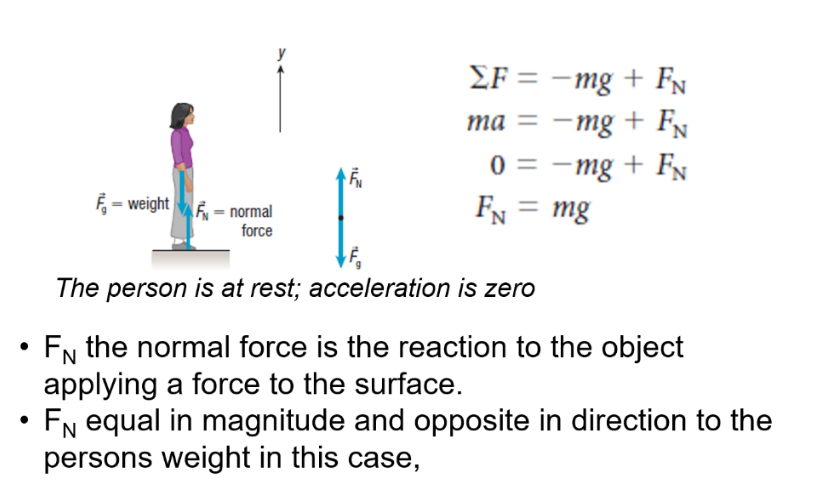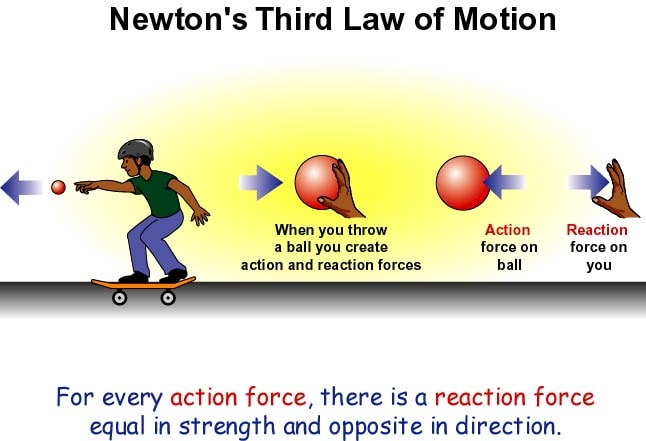Forces & Newton's Laws
Forces
- A force is a push or pull
- A force is a vector quantity so a direction must be included
- Force is measured in Newtons (N)
Common Forces
- Contact Force: a force that occurs in between two objects when they touch
- Non-contact force: a force that occurs between objects without them touching
- action at a distance force
Fundamental Forces
There are 4 fundamental types of forces
Gravitational Force
Electromagnetic Force
Strong Nuclear Force
Weak Nuclear Force

Common Forces
Applied Force
- a general term for a force that experiences contact
- example: pushing a box
- the push is the applied force onto the box
Force of Gravity
- The force of attraction that acts between all objects.
- The force of attraction between an object and a planet is called the object’s weight
- Value: 9.8 m/s^2 [down]
- Sometimes called weight
- Example: a box at rest
- the force of gravity is acting on the box
Normal Force
- Pushes back against other forces
- Always acts perpendicular (normal) to a surface
Friction
- resists motion
- acts to oppose motion
- is caused by electrical forces between two surfaces
- acts between objects in contact.
- friction in the air is called air resistance
- Friction can be both a good and bad thing
- Good when our tires meet the pavement,
- Bad when reducing efficiency and/or producing heat
- Applies to situations where:
- Fnet = 0
- Fnet = ma
- acts in the opposite direction of motion (opposes motion)
- Static Friction: acts between surfaces at rest but tends to move
- a force of friction that prevents the sliding of two surfaces relative to one another
- The magnitude of the force needed to start a stationary object moving is the maximum static friction
- Kinetic Friction: acts between surfaces moving over each other
- the force exerted on a moving objects by a surface opposite to the direction of motion.
- Kinetic friction acts on any object that is in motion
- The magnitude of the force needed to keep the object moving at a constant velocity is the kinetic friction
- The magnitudes of friction depend on
- the surfaces in contact with each other (ie. shoe and floor)
- the normal force
Coefficients of Friction

Air Resistance
- Friction between an object and the air
Tension
- a force acting on an object through strings, cables, ropes etc.
Symbols

System Diagrams & FBDs
A system diagram is a sketch of all of the objects involved in a situation.
A Free Body Diagram (FBD) is a drawing of a single object that shows only the forces (as vectors) acting on that object.
Always indicate the +x and +y directions

Net Force
The Net Force is the sum of all of the forces acting on an object.
We must consider forces in the x-direction (horizontal) or y-direction (vertical) separately.

Newton’s Laws
Newton’s Fist Law: Inertia
- If the net force acting on an object is zero, that object maintains its state of rest or constant velocity.
- This does not mean that the object is standing still
Inertia
- Inertia is an attribute of matter that makes it resistant to changes in motion
- The object's mass affects inertia.
- An object with more mass has more inertia, whereas an object with less mass has less inertia
- Inertia is directly proportional to the mass of the object.
- Unless another force acts on it, an object at rest or at a constant speed will have a net force of zero.
Implications
- To keep an object moving, no net force is required.
- An object's velocity will be altered by a non-zero force if its direction, magnitude, or both are altered.
- An object's motion cannot be altered by internal forces. Object motion is unaffected by internal forces.
Examples
- Stomping removes snow and mud from your boots
- The mud particles accelerate from rest to some velocity when the leg is pushed downward. Newton's first law states that when the boot suddenly stops moving, the mud particles continue to move forward and maintain their state of motion. As soon as the mud splatters and the boot lose its bond, the mud splatters fall off the boot.
- A student is standing in the aisle of a bus that is moving steadily while not holding on. The student suddenly falls backwards. How has the bus's motion changed?
- The student and the bus will both be moving at the same constant speed. Due to friction, when the bus accelerates, the student's feet that are in contact with the floor of the bus also accelerate at the same rate as the bus. However, because of its inertia (Newton's first law), the student's upper body continues to move at the same initial speed. Because the student's feet have moved more quickly than his or her upper body, it will appear as though they are falling backward. Therefore, it can be said that the bus has accelerated forward
More Examples:
- Seatbelts
- Child Care Seats
- Air Bags
Applications of N1L
- When a pickup truck is moving, you shouldn't stand in the back (bed) of the vehicle.
- The person in the back of the truck will move at the same constant speed as the truck if it is moving forward at that speed. Due to its inertia, the person's body will continue to move at the truck's initial speed even as the truck slows down. The person will seem to move forward more quickly, possibly hitting the cab and getting hurt.
- The person in the back of the truck will move at the same speed as the truck if it is moving forward at a constant speed. Due to friction, when the truck slows down, the person's feet that are in contact with the truck bed will also slow down at the same rate. Due to the inertia of the person's upper body, the truck will continue to move at its initial speed. It will seem as though the person is falling forward, possibly hurting themselves.
- The person in the back of the truck will move at the same speed as the truck if it is moving forward at a constant speed. Due to friction, when a truck accelerates, a person's feet that are in contact with the truck bed accelerate at the same rate. Due to the inertia of the person's upper body, the truck will continue to move at its initial speed. The person appears to fall backward, possibly hurting themselves on the way out.
Newton’s Second Law
When the net force is not zero, Newton's second law (N2L) applies.
If an object experiences a net force that is greater than zero, the object will accelerate in the direction of the net force
The magnitude of the acceleration is directly proportional to the magnitude of the net force and is inversely proportional to the object’s mass.
- Acceleration is dependent on the mass and the net force of an object
- As the mass of an object is increased, the __acceleration __decreases
- As the net force acting on the object is increased, the __acceleration __increases.

m is the mass
- measured in kilograms (kg)
a is acceleration
- measured in m/s^2
Fnet is the net force
- measured in Newtons (N)
Weight
Weight is the gravitational force exerted by the Earth onto an object
An object in free fall experiences an acceleration
- Acceleration is equal to gravity in the downwards direction


Newton’s Third Law
%%For every action, there is an equal reaction in the opposite direction%%


Gravitational Forces
- Mass is the quantity of matter in an object.
- Weight is the force of gravity on an object.
- Weight can change but mass cannot
Free Fall
- The motion of a falling object where the only force acting is gravity
Air Resistance
- A force opposing the motion of objects through the air.
- Numerous variables affect the amount of air resistance that an object experiences.
- Air resistance is greater for larger cross-sectional areas than for smaller cross-sectional areas.
- The amount of air resistance increases as an object's speed increases.
Terminal Speed
- the maximum constant speed of a falling object
Gravity
- Gravity is a force that operates at a distance and pulls on objects without actually coming into contact with them.
- There is a gravitational force field that encompasses the Earth.
- A force field is a region of space that surrounds an object and has the power to push other objects around it.
Force Field of Gravity
- The force field is represented by lines of force that points toward Earth’s centre
- Masses will always be attracted to Earth when it interacts with the force field
Gravitational Field Strength
Gravitational field strength is the force per unit mass acting on an object when placed in a gravitational field.
Gravitational field strength is also called the acceleration due to gravity.
Earth’s Field strength decreases as the distance from the surface increases.
At the top of Mount Everest, 8848 m above sea level, the field strength is 9.7647 N/kg
- This place has the lowest gravitational field strength

Factors Affecting Gravity
As the Earth is not a perfect sphere, gravity depends on the geographic location of an object
Earth bulges out slightly at the equator due to the rotation of the planet.
An object at sea level at the poles is 21 km closer to Earth’s centre than if it were at sea level at the equator.
The gravitational field is strength greater at the poles than at the equator.


Apparent Weight

Law of Universal Gravitation
Every pair of masses in the universe is attracted to one another by a mutual force of attraction.
This force varies directly with the magnitude of each mass, and inversely with the square of the distance between them.
Center to centre measurement determines the separation between the masses.
